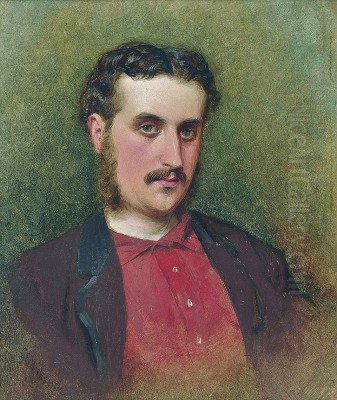
George Elgar Hicks stands as a significant figure in the landscape of British Victorian art. Active during a period of immense social, industrial, and cultural transformation, Hicks dedicated much of his career to capturing the multifaceted nature of contemporary life in nineteenth-century Britain. Born on March 13, 1824, in Lymington, Hampshire, and passing away on July 4, 1914, just before the outbreak of the First World War, his long life spanned a dynamic era. He is best remembered for his large-scale genre paintings, teeming with figures and detail, as well as his later work in portraiture, leaving behind a valuable visual record of his time.
Early Life and A Reluctant Path to Art
George Elgar Hicks was the second son of a prosperous magistrate, and his family initially envisioned a different career path for him. Following conventional expectations for a young man of his standing, his parents encouraged him to pursue medicine. Consequently, from 1840 to 1842, Hicks dutifully studied medicine at University College London. However, this period proved to be profoundly unsatisfying for him. Sources describe his medical studies as "arduous and disagreeable," suggesting a fundamental lack of passion for the subject.
This dissatisfaction ultimately led him to abandon medicine and embrace his true calling: art. In 1843, he took the decisive step of enrolling at Sass's Academy, a well-regarded preparatory school for aspiring artists in London, founded by Henry Sass. This was followed swiftly by his admission to the prestigious Royal Academy Schools in 1844. Compared to many of his contemporaries who might have started formal art training earlier, Hicks's entry into the art world was somewhat delayed, a consequence of his initial foray into medicine. This later start, however, did not ultimately impede his eventual success.
Forging an Artistic Identity: Early Career and Influences
Hicks's initial years as a professional artist were not marked by immediate triumph. Like many artists, he faced a period of establishing his reputation and finding his artistic voice. His career began to gain traction around 1848, but it was particularly in the late 1850s that he achieved significant public recognition. This rise coincided with his focus on genre painting, specifically large canvases depicting bustling scenes drawn from modern London life.
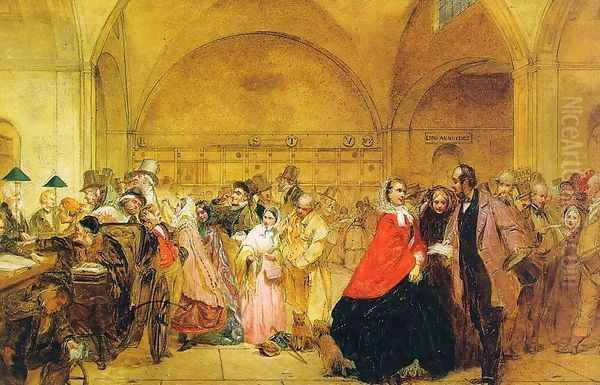
A pivotal influence on Hicks's style and choice of subject matter was William Powell Frith (1819-1909). Frith had achieved phenomenal success with panoramic paintings of contemporary events and social gatherings, such as Ramsgate Sands (Life at the Seaside) (1854), The Derby Day (1858), and The Railway Station (1862). These works, characterized by their detailed realism, narrative clarity, and depiction of diverse social types, captivated the Victorian public and set a benchmark for modern-life painting. Hicks is often described as one of Frith's principal followers or imitators, adopting a similar approach to composition and detail.
Despite the clear influence, Hicks sought out subjects that, while fitting the mould of modern-life scenes, were sometimes distinct from Frith's typical choices. He explored aspects of urban infrastructure and commerce that were relatively novel artistic territory. His early career was thus defined by this engagement with contemporary genre painting, navigating the powerful influence of Frith while striving to carve his own niche. His marriage in 1847 to Maria Harries, with whom he would have six children, also shaped this period; the responsibilities of family life likely required him to balance domestic duties with the demanding pursuit of an artistic career.
Breakthrough: Dividend Day and Public Acclaim
The turning point in George Elgar Hicks's career arrived in 1859 with the exhibition of Dividend Day at the Bank of England at the Royal Academy. This large, meticulously detailed painting depicted the scene inside the Rotunda of the Bank of England as investors queued to collect their dividends. It was precisely the kind of crowded, contemporary subject, rich in social observation and narrative potential, that resonated with the Victorian public, much like the works of William Powell Frith.
The painting showcased Hicks's ability to manage complex multi-figure compositions and capture a cross-section of society, from wealthy investors to clerks and onlookers. The attention to costume, expression, and architectural detail demonstrated his commitment to realism. Its acceptance and exhibition at the Royal Academy, the epicentre of the British art world, signified a major success for Hicks. It cemented his reputation as a capable painter of modern life and brought him widespread recognition. This success marked his arrival as a significant artist within the popular genre painting movement.
Following Dividend Day, Hicks produced several other notable works in a similar vein during the late 1850s and early 1860s, capitalizing on the public's appetite for these vivid portrayals of contemporary London. He had found a successful formula, closely aligned with Frith's popular model, but increasingly applied to his own chosen subjects.
Chronicling the Metropolis: Key Genre Paintings
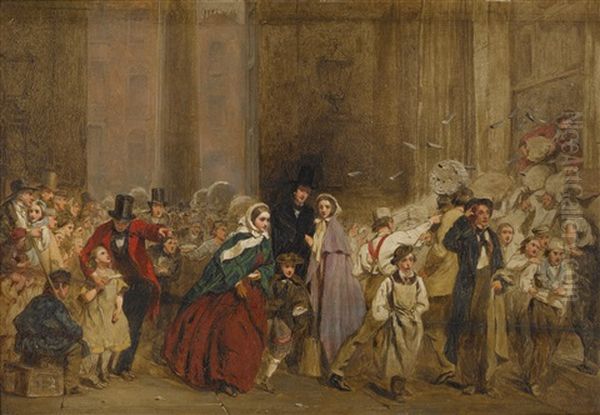
Building on the success of Dividend Day, Hicks created several other major genre paintings that stand as key examples of his work and offer fascinating glimpses into Victorian London. Among the most famous is The General Post Office, One Minute to Six, exhibited in 1860. This painting captures the frantic last moments before the deadline for posting mail at the General Post Office at St Martin's-le-Grand. It depicts a diverse crowd rushing to post letters and newspapers, highlighting the increasing pace of life and the importance of communication in the mid-nineteenth century. The sense of urgency and the variety of characters, from businessmen to errand boys, make it a dynamic snapshot of urban activity.
Another significant work is Billingsgate Fish Market (1861). Here, Hicks turned his attention to the bustling world of commerce at London's primary fish market. The scene is crowded with fishwives, porters, merchants, and customers, capturing the raw energy and distinct atmosphere of the location. Like his other major genre works, it presents a cross-section of society engaged in the daily life of the city. These paintings, along with Dividend Day, exemplify Hicks's skill in orchestrating complex scenes and his interest in documenting the varied institutions and activities that defined modern London.
While clearly indebted to William Powell Frith's model of panoramic social observation, Hicks's choice of subjects like the Post Office and Billingsgate demonstrated a willingness to explore different facets of the urban experience. These works solidified his reputation as a painter who could capture the pulse of the metropolis in intricate detail.
The Victorian Genre Painting Context
George Elgar Hicks operated within a thriving tradition of genre painting in Victorian Britain. This mode of art, focusing on scenes of everyday life, was immensely popular with the rapidly expanding middle class, who saw their own lives and values reflected or commented upon in these works. Artists like Hicks and Frith provided detailed, often narrative-rich canvases that were easily readable and offered opportunities for social observation, moral reflection, or simply enjoyment of familiar scenes rendered with impressive skill.
Besides William Powell Frith, other contemporaries explored similar territory, though often with different emphases. Augustus Egg (1816-1863), for instance, used contemporary settings for powerful moral dramas, such as his triptych Past and Present (1858), which dealt with the consequences of marital infidelity. Later artists associated with Social Realism, like Luke Fildes (1843-1927) with his stark Applicants for Admission to a Casual Ward (1874), or Frank Holl (1845-1888) and Hubert von Herkomer (1849-1914), often depicted the harsher realities of poverty and working-class life with a more overt social critique than typically found in Hicks's or Frith's work.
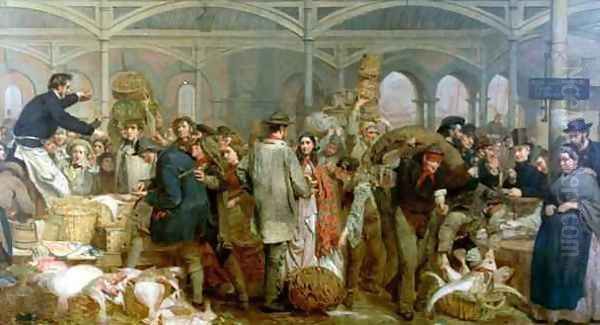
Hicks's paintings, while detailed and observant, generally maintained a more neutral or celebratory tone compared to the pointed social commentary of some of his peers. His focus was often on the energy, diversity, and functioning systems of modern life – finance, communication, commerce. His style, aligned with Frith's, emphasized detailed realism and narrative clarity, appealing to a broad audience and securing commercial success, even if occasionally drawing criticism for a perceived lack of profound innovation compared to, say, the Pre-Raphaelite Brotherhood (like John Everett Millais, William Holman Hunt, Dante Gabriel Rossetti) who pursued a different kind of detailed realism often linked to literary or historical themes.
A Shift in Direction: Portraiture and Later Themes
By the late 1860s and into the 1870s, the immense popularity of the large-scale, panoramic modern-life genre painting began to wane slightly. Artistic tastes were gradually shifting, and perhaps Hicks himself sought new challenges or avenues for patronage. During this period, he increasingly turned his attention towards historical subjects and, significantly, portraiture. This shift proved successful, and he established himself as a competent and sought-after portrait painter.
His portraits often depicted members of the upper-middle and aristocratic classes, reflecting the demand for such work among wealthy patrons. An example includes the Portrait of Adelaide Maria Countess of Iveagh. While perhaps less innovative than his earlier genre scenes, his portraiture provided a steady source of income and kept him active within the art establishment. His skill in capturing likeness and rendering textures, honed through his detailed genre work, served him well in this field. Other prominent Victorian portraitists included figures like George Frederic Watts (1817-1904), known for his 'Hall of Fame' portraits of eminent Victorians, and John Everett Millais (1829-1896), who, after his Pre-Raphaelite beginnings, became one of the most successful and highly paid society portraitists of the era.
Alongside portraiture, Hicks also explored subjects with a more overt social or moral message, often on a smaller scale than his earlier panoramic works. The most notable example is the triptych Woman's Mission, consisting of three panels: Guide of Childhood, Companion of Manhood, and Comfort of Old Age (1863). This series depicted the idealized roles of women within the domestic sphere according to conventional Victorian ideology – nurturing children, supporting husbands, and caring for the elderly. While reflecting common societal views, the work offers insight into the period's gender expectations and Hicks's engagement with themes beyond bustling public scenes.
Artistic Style and Technique
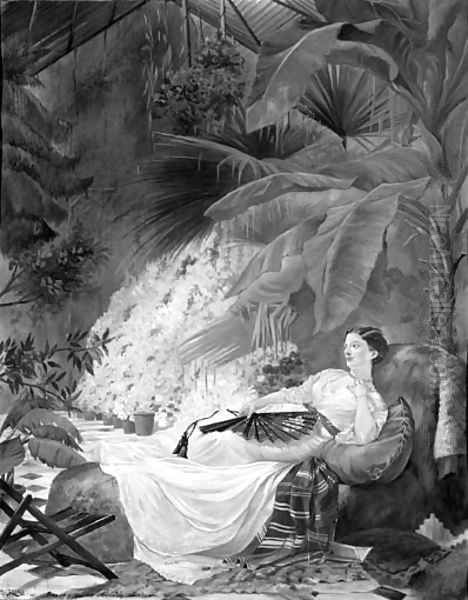
George Elgar Hicks's artistic style is firmly rooted in Victorian realism. His primary aim, particularly in his celebrated genre paintings, was to create a convincing and detailed representation of the world around him. This involved meticulous attention to detail in rendering costumes, facial expressions, architectural settings, and the myriad objects that populated his scenes. His canvases are often characterized by their high finish, with smooth brushwork that minimizes the artist's hand to enhance the illusion of reality.
His compositions, especially in works like Dividend Day and The General Post Office, are typically complex and panoramic. He employed a wide viewpoint to encompass large crowds and expansive settings, arranging figures in overlapping groups to create a sense of depth and bustling activity. Narrative clarity was paramount; viewers were intended to be able to 'read' the scene, identifying different social types and understanding the interactions taking place. This often involved using anecdotal details and expressive gestures to convey individual stories within the larger tableau.
His use of colour was generally bright and clear, contributing to the overall legibility and vibrancy of the scenes. While heavily influenced by William Powell Frith, Hicks developed his own particularities, perhaps a slightly less theatrical staging in some works, and his unique choice of subjects like the Post Office. Although his style might be seen as less radical than the contemporary experiments of the Pre-Raphaelites or the burgeoning Impressionist movement in France (led by artists like Claude Monet and Edgar Degas), Hicks's technical proficiency and commitment to detailed observation were widely acknowledged during his peak years.
Personal Life and Later Years
George Elgar Hicks's personal life intertwined with his long artistic career. His first marriage to Maria Harries in 1847 resulted in a large family of six children. While providing domestic stability, the demands of supporting a family were significant, potentially influencing his focus on commercially viable genres like detailed modern-life scenes and later, portraiture. Maria passed away in 1884, marking a significant personal loss for the artist.
Four years later, in 1888, Hicks remarried. His second wife was Kate Marion Collins. His later life appears to have been relatively quiet compared to the period of his greatest public fame in the 1860s. He continued to paint, focusing primarily on portraits and potentially less demanding subjects than the large, intricate genre scenes of his middle career. He eventually retired from active painting in the 1890s.
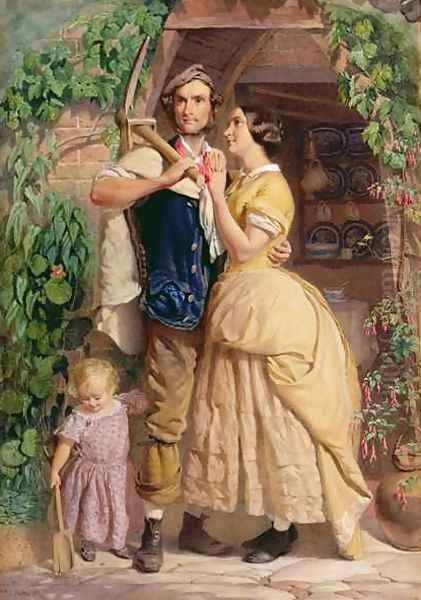
He lived to the venerable age of 90, passing away on July 4, 1914, in Odiham, Hampshire. His death occurred just weeks before the outbreak of World War I, an event that would irrevocably change the social landscape he had spent much of his career documenting. His long lifespan allowed him to witness the entirety of the high Victorian era and the transition into the Edwardian period.
Legacy and Reputation
George Elgar Hicks occupies a solid, if secondary, position in the canon of British Victorian art. While often overshadowed by his primary influence, William Powell Frith, Hicks made a distinct contribution through his choice of subjects and his diligent chronicling of London life. His major genre paintings, such as Dividend Day at the Bank of England, The General Post Office, One Minute to Six, and Billingsgate Fish Market, remain valuable historical documents, offering rich visual information about the institutions, social interactions, and atmosphere of the mid-Victorian metropolis.
His work exemplifies the popular taste for detailed, narrative realism that dominated much of the Victorian era. While his style eventually fell out of fashion with the rise of modernism, there has been renewed art historical and social historical interest in his work. Scholars now appreciate his paintings not just for their technical skill but for the insights they provide into Victorian society, commerce, gender roles (as seen in Woman's Mission), and urban experience. His paintings capture a sense of energy and diversity, reflecting the confidence and complexity of Britain at the height of its imperial power.
Today, Hicks's works are held in major public collections, including Tate Britain, the Museum of London, and the British Museum, ensuring their accessibility for study and appreciation. While perhaps not considered an innovator on the scale of J.M.W. Turner or John Constable from earlier generations, or his more radical contemporaries like the Pre-Raphaelites or later figures influenced by French Impressionism, Hicks remains significant as a skilled practitioner and a keen observer of his time, a visual storyteller who captured the intricate fabric of Victorian life. His relationship with Frith defines much of his reception, but his own achievements in depicting the specific workings of the city give him a unique place in nineteenth-century British art.